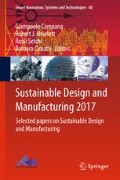Abstract
In recent years, the additive manufacturing processes have rapidly developed. The additive manufacturing processes currently present a high-performance alternative to conventional manufacturing methods. In particular, they offer the opportunity of previously hardly imaginable design freedom, i.e. the implementation of complex forms and geometries. This capability can, for example, be applied in the development of especially light but still loadable components in automotive engineering. In addition, waste material is seldom produced in additive manufacturing which benefits a sustainable production of building components. Until now, this design freedom was barely used in the construction of technical components and products because, in doing so, both specific design guidelines for additive manufacturing and complex strength calculations must be simultaneously observed. Yet in order to fully take advantage of the additive manufacturing potential, the method of topology optimization, based on FEM simulation, suggests itself. It is with this method that components that are precisely matched and are especially light, thereby also resource-saving, can be produced. Current literature research indicates that this method is used in automotive manufacturing for reducing weight and improving the stability of both individual parts and assembly units. This contribution will study how this development method can be applied in the example of a brake mount from an experimental vehicle. In this, the conventional design is improved by means of a simulation tool for topology optimization in various steps. In an additional processing step, the smoothing of the thus developed component occurs. Finally, the component is generatively manufactured by means of selective laser melting technology. Models are manufactured using binder jetting for the demonstration of the process. It will also be determined how this weight reduction affects the CO2 emissions of a vehicle in use.
Access this chapter
Tax calculation will be finalised at checkout
Purchases are for personal use only
References
Gibson, I., Rosen, D.W., Stucker, B.: Additive Manufacturing Technologies: 3D Printing, Rapid Prototyping, and Direct Digital Manufacturing. Springer, New York (2014)
Wohlers, T.: Wohlers Report - Additive Manufacturing and 3D Printing State of the Industry Annual Worldwide Progress Report. Wohlers Associates Inc., Fort Collins (2014)
Junk, S., Sämann-Sun, J., Niederhöfer, M.: Application of 3D printing for the rapid tooling of thermoforming moulds. In: Srichand, H., Lin, L. (eds.) Proceedings of the 36th International MATADOR Conference, pp. 369–372, Springer, London (2010)
Yoon, H.-S., Lee, J.-Y., Kim, H.-S., Kim, M.-S., Kim, E.-S., Shin, Y.-J., Chu, W.-S., Ahn, S.-H.: A comparison of energy consumption in bulk forming, subtractive, and additive processes review and case study. Int. J. Precis. Eng. Manuf. Green Technol. 1(3), 261–279 (2014)
Campbell, I., Bourell, D., Gibson, I.: Additive manufacturing: rapid prototyping comes of age. Rapid Prototyping J. 18(4), 255–258 (2012)
Mueller, B., Hund, R., Malek, R., Gebauer, M., Polster, S., Kotzian, M., Neugebauer, R.: Added value in tooling for sheet metal forming through additive manufacturing. In: International Conference on Competitive Manufacturing, pp. 1–7 (2013)
Frisch, M., Glenk, C., Dörnhöfer, A., Rieg, F.: Topology optimization for small and medium-sized enterprises - from experience-based construction to the use of topology optimization for the product development process. ZWF Zeitschrift für wirtschaftlichen Fabrikbetrieb 111(5), 243–246 (2016)
Pacurar, R., Pacurar, A.T.: Topology optimization of an airplane component to be made by selective laser melting technology, Modern Technologies in Manufacturing, MTeM. In: International Conference on Modern Technologies in Manufacturing (2015). Appl. Mech. Mater. 808, 181–186. Trans Tech Publication, Zürich
Oliveira, J., Teixeira, P., Lobo, G., Duarte, J., Reis, A.: Topology optimization of a car seat frame, the current State-of-the-Art on material forming. In: 16th International ESAFORM Conference on Material Forming, ESAFORM (2013)
Guangyao, L., Fengxiang, X., Xiaodong, H., Guangyong, S.: Topology optimization of an automotive tailor-welded blank door. Trans. ASME J. Mech. Des. 137(5), 1–8 (2015)
Chen, D., Heyer, S., Ibbotson, S., Salonitis, K., Steingrímsson, J.G., Thiede, S.: Direct digital manufacturing: definition. Evol. Sustain. Implications J. Cleaner Prod. 107, 615–625 (2015)
Stroobants, J., Campestrini, P.: Component optimisation through simulation driven design. Topology & topography optimization. In: Proceedings of 3rd Commercial Vehicle Technology Symposium on Commercial Vehicle Technology, CVT (2014)
Li, C., Kim, I.Y.: Topology, size and shape optimization of an automotive cross car beam. Proc. Inst. Mech. Eng. Part D J. Automobile Eng. 229(10), 1361–1378 (2015)
Salonitis, K.: Design for additive manufacturing based on the axiomatic design method. Int. J. Adv. Manuf. Technol. 87, 989–996 (2016)
Salonitis, K., Al Zarban, S.: Redesign optimization for manufacturing using additive layer techniques. Procedia CIRP 36, 193–198 (2015)
Madenci, E., Guven, I.: The Finite Element Method and Applications in Engineering Using ANSYS®. Springer, New York (2016)
Rozvany, G., Lewiński, T. (eds.): Topology Optimization in Structural and Continuum Mechanics. Springer, Heidelberg (2013)
Lachmayer, R., Lippert, R.B., Fahlbusch, T. (eds.): 3D-Druck beleuchtet - Additive Manufacturing auf dem Weg in die Anwendung. Springer, Heidelberg (2016)
Cheah, L., Heywood, J., Kirchain, R.: The Energy of Impact US Passenger Vehicle Fuel Economy Standards. MIT, Cambridge (2008)
Kenny, T., Gray, N.F.: Comparative performance of six carbon footprint models for use in Ireland. Environ. Impact Assess. Rev. 29(1), 1–6 (2009)
Author information
Authors and Affiliations
Corresponding author
Editor information
Editors and Affiliations
Rights and permissions
Copyright information
© 2017 Springer International Publishing AG
About this paper
Cite this paper
Junk, S., Fleig, C., Fink, B. (2017). Improvement of Sustainability Through the Application of Topology Optimization in the Additive Manufacturing of a Brake Mount. In: Campana, G., Howlett, R., Setchi, R., Cimatti, B. (eds) Sustainable Design and Manufacturing 2017. SDM 2017. Smart Innovation, Systems and Technologies, vol 68. Springer, Cham. https://doi.org/10.1007/978-3-319-57078-5_15
Download citation
DOI: https://doi.org/10.1007/978-3-319-57078-5_15
Published:
Publisher Name: Springer, Cham
Print ISBN: 978-3-319-57077-8
Online ISBN: 978-3-319-57078-5
eBook Packages: EngineeringEngineering (R0)

